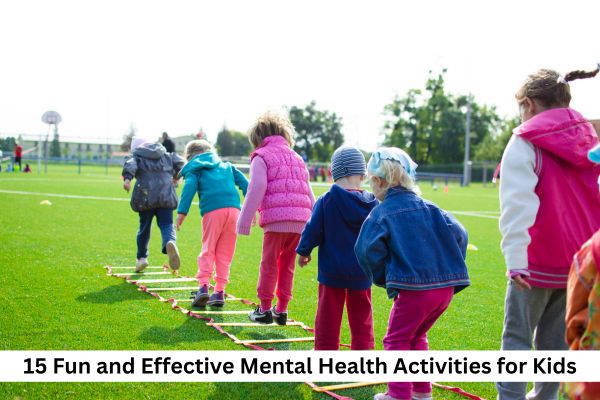Kids today juggle more than we realize schoolwork, friendships, screen time, and big emotions that can sometimes feel overwhelming. Just like their bodies need exercise, their minds need practice too. That’s why introducing mental health activities for kids is so important.
These activities act as simple yet powerful tools to help children manage stress, build confidence, and express their feelings in healthy ways. In this guide, we’ll explore practical and engaging mental health activities for kids that parents, teachers, and caregivers can easily introduce into everyday life.
Key Highlights
- Mental health is very important for kids, as it helps them manage emotions, build resilience, develop healthy relationships, and cope with stress in positive ways.
- Kids face stress from school, friendships, and screen time—mental health activities help them build resilience, confidence, and coping skills.
- Effective activities are simple, engaging, age-appropriate, low-cost, repeatable, and supported by adults.
- Fun solo activities include Gratitude Jar, Bubble Breathing, Yoga for Kids, Feelings Charades, and Calm Down Corner.
- Group activities like Compliment Circle, Emotion Bingo, Team Mural, and Role-Playing encourage empathy, teamwork, and social skills.
- Small, consistent practices woven into daily routines support kids’ long-term emotional well-being and mental health.
Understanding the Basics
So, what do we mean by mental health in childhood? It’s not just about “feeling happy.” It’s about being able to handle emotions, adapt to changes, and build positive relationships.
Kids face stress too, including tests, social pressures, or even adjusting to new environments. Left unchecked, these challenges can lead to frustration or anxiety. But with the right activities, kids learn skills that last a lifetime: emotional vocabulary, mindfulness, and resilience.
Why Mental Health Activities for Kids Matter?
Childhood is supposed to be joyful and carefree, right? Well, not always. Kids experience stress in different forms:
- Academic pressure from schoolwork and exams
- Social challenges like making friends or dealing with bullies
- Emotional struggles from big life changes such as moving or divorce
- Constant exposure to technology and social media (for older kids)
Left unchecked, these stresses can lead to anxiety, low self-esteem, or behavioral issues. But here’s the good news: with consistent practice, kids can develop coping mechanisms that last a lifetime.
What Makes an Activity Truly Effective?
Not every craft, game, or exercise automatically supports mental health. Kids are smart—they can sense when something feels forced or when it’s just another “assignment” disguised as fun. To really make a difference, the best fun mental health activities for kids share a few key qualities:
1. Simple
Activities don’t need to be complicated or full of instructions. Kids thrive on clarity. For example, something as easy as blowing bubbles for deep breathing or writing one word in a gratitude jar can be far more powerful than a complex worksheet. If an activity feels confusing, children may get frustrated and disengage. Simplicity ensures they can jump right in and enjoy the process.
2. Engaging
Children learn best when they’re having fun. An effective activity should capture their attention and feel more like play than therapy. For instance, “Feelings Charades” gets kids laughing while also teaching them to identify emotions. Engagement is key because if kids enjoy the process, they’re more likely to repeat it and benefit over time.
3. Age-Appropriate
What works for a preschooler won’t necessarily work for a tween. A five-year-old may connect best with drawing how they feel, while a 12-year-old might prefer journaling or practicing mindfulness. Tailoring activities to developmental stages makes them more meaningful and effective. It’s like choosing the right-sized bike—if it doesn’t fit, it won’t work.
4. Low-Cost or Free
Supporting children’s mental health doesn’t need to break the bank. Some of the most effective tools are everyday items—paper, crayons, a stuffed animal, or even a walk outside. For example, the “Breathing Buddy” activity only requires a favorite toy. By keeping activities affordable, they become more accessible to all families and schools.
5. Repeatable
Consistency is what builds real change. The most effective mental health activities for kids can be practiced daily or weekly without losing their appeal. Think of brushing teeth, it’s not glamorous, but the regular habit makes all the difference. When kids can repeat an activity often, it becomes a natural part of their coping toolkit.
6. Supportive
Finally, the role of adults cannot be underestimated. Kids look to parents, teachers, and caregivers for guidance. When an adult joins in, whether it’s coloring alongside them, doing yoga together, or sharing their own gratitude entry, it shows kids that mental health is something everyone can work on. Support makes the activity more powerful and strengthens the bond between adult and child.
15 Fun Mental Health Activities for Kids
These are easy-to-try, creative activities that children can do at home, one-on-one with a parent, in classrooms, or independently as they grow older. The best part is they don’t require fancy tools or big budgets—just a little time and creativity.
1. Feelings Charades
Instead of acting out animals or actions, act out emotions like “angry,” “excited,” or “nervous.” Kids not only learn to identify and label emotions but also get to laugh and move around. This game works beautifully as one of the mental health group activities for kids in classrooms because it sparks empathy and helps children understand that everyone experiences a wide range of feelings.
Pro tip: After each round, ask, “When was the last time you felt this way?” to open up conversations about real-life emotions.
2. Gratitude Jar
Each day, children write or draw something they’re thankful for and place it in a decorated jar. At the end of the week or month, open the jar and read the notes together. This practice helps kids shift their focus from worries to joys, building a more positive mindset.
Why it works: Gratitude rewires the brain to notice the good, which is especially helpful for kids who might dwell on negative experiences.
3. Mindful Coloring
Coloring is more than just fun—it’s a form of meditation in disguise. Give kids mandalas, nature scenes, or abstract doodles, and let them quietly focus on patterns and colors. It calms racing thoughts and improves concentration.
Extra tip: Play soft background music while they color for added relaxation.
4. Worry Box
Kids write down their worries on slips of paper and drop them into a special box. The physical act of “placing” worries somewhere else teaches them to let go of anxious thoughts. Over time, this creates a visual reminder that worries don’t have to stay stuck in their minds.
Group twist: In a classroom, children can decorate a shared “worry monster box” where everyone feeds their worries to the monster.
5. Nature Walk Mindfulness
Head outside and play the “five senses game.” Ask your child to name one thing they can see, hear, smell, touch, and taste (safely, like a fruit or snack). It’s a grounding technique that helps kids reconnect with the present moment.
Why it’s great: Nature itself is calming, and when paired with mindfulness, it becomes a double dose of stress relief.
6. Yoga for Kids
Yoga poses like “tree,” “child’s pose,” or “cat-cow” help kids release pent-up energy and calm their busy minds. Because many yoga poses are named after animals, kids find them playful and relatable.
Try this: End the session with “savasana” (lying still on the floor) where kids imagine they’re melting into the ground—perfect for relaxation.
7. Breathing Buddies
Ask your child to lie down with a stuffed animal on their stomach. As they take slow, deep breaths, the toy rises and falls. This turns deep breathing into a visual, interactive game that helps children understand how to regulate their breathing when they feel anxious.
Pro tip: Use this activity at bedtime to help kids wind down.
8. Feelings Collage
Grab old magazines, scissors, and glue. Ask kids to cut out faces, colors, or images that represent different emotions, then glue them into a “feelings collage.” It’s a creative way for kids to explore emotions they may not have the words to express yet.
Why it matters: For visual learners, this is one of the most effective fun mental health activities for kids because it makes abstract emotions concrete.
9. Positive Affirmation Cards
Kids design colorful cards with uplifting phrases like “I am strong,” “I am loved,” or “I can do hard things.” Reading them daily builds self-esteem and resilience.
Make it stick: Place the cards on a mirror, lunchbox, or school binder so kids see them regularly.
10. Journaling Emotions
Older kids can write about their day while younger children can draw pictures to express feelings. Journaling helps children process emotions instead of bottling them up.
11. Dance it Out
Turn on a playlist and let kids dance however they want. Movement is a natural mood booster, and dancing gives kids permission to express emotions through their bodies.
Why it’s powerful: This doubles as exercise, helping release endorphins (the brain’s “feel-good” chemicals).
12. Bubble Breathing
Hand your child a bottle of bubbles and encourage them to take slow, deep breaths to make the bubbles float longer. It’s a playful way to practice breathing techniques without kids even realizing they’re learning mindfulness.
Fun twist: Try a “bubble contest” to see who can blow the slowest, longest bubble.
13. Create a Calm Down Corner
Set up a cozy space with pillows, stuffed animals, soft lighting, and calming tools like coloring books or fidget toys. This “safe space” gives kids somewhere to go when they feel overwhelmed.
At school: Teachers can create a “peace corner” where students can step away for a few minutes to regulate emotions before rejoining activities.
14. Storytelling with Emotions
Sit down together and create a story where each character has a unique feeling—one is happy, one is scared, one is proud. Kids build empathy by imagining how emotions influence behavior.
Bonus tip: Add puppets or stuffed animals to make storytelling even more engaging.
15. Emotion Wheel Game
Make or print a wheel with different emotions written on it. Spin it, then ask your child to act out that feeling or share a time they experienced it. This builds emotional vocabulary and encourages kids to reflect on their own experiences.
Why it works: Kids often struggle to name their emotions. This game makes it easier by turning it into a visual, interactive activity.
10 Best Mental Health Group Activities for Kids
While solo activities are helpful, group settings add a social element that’s equally important. Kids learn teamwork, empathy, and communication through mental health group activities for kids.
1. Compliment Circle
Sitting in a circle, each child gives a compliment to the person next to them. This builds self-worth and teaches kindness.
2. Emotion Bingo
Instead of numbers, bingo cards feature emotions like “happy,” “sad,” or “angry.” When an emotion is called out, kids must share a story or face that matches it.
3. Team Mural
Work together to create a mural or collage on themes like happiness, friendship, or safety. Collaboration fosters a sense of belonging.
4. Circle Sharing
Give each child a chance to share one positive thing about their day. It encourages reflection and gratitude.
5. Role-Playing Games
Act out common scenarios—like resolving an argument or asking for help from a teacher. Kids gain problem-solving and social skills.
6. Pass the Smile
Sit in a circle. One person starts with a big smile and “passes” it to the next. Watch as laughter spreads naturally.
7. Kindness Challenge
In a group, brainstorm acts of kindness and try to complete as many as possible in a week.
8. Emotion Freeze Dance
Play music and let kids dance. When the music stops, call out an emotion, and they must freeze in a pose that matches it.
9. Guided Group Meditation
Lead kids through a short visualization, like imagining a safe, happy place. Practicing mindfulness together creates a calm group atmosphere.
10. Team Gratitude Wall
Give everyone sticky notes to write things they’re grateful for and post them on a shared wall or board.
Making These Activities Part of Daily Life
The best way to support children’s mental health is to make these practices routine, not one-offs. A few tips:
- Start small: Just five minutes a day can make a difference.
- Blend with existing routines: Morning check-ins or bedtime reflections fit seamlessly into daily life.
- Model the behavior: Kids learn best when adults participate too.
- Be flexible: Let children choose which activity resonates most with them.
Conclusion
Supporting children’s mental health doesn’t require big, complicated steps—it’s about adding simple, engaging practices into daily routines. From a gratitude jar at home to a calm down corner in the classroom, these mental health activities for kids give them practical tools to manage stress, build confidence, and express emotions in healthy ways.
Whether practiced individually or through mental health group activities for kids, each activity helps kids grow stronger emotionally and socially. By starting small and staying consistent, parents, teachers, and caregivers can create a supportive environment where children feel safe, resilient, and ready to thrive.
Frequently Asked Questions
Mental health is important for kids as they help children build coping skills, boost self-esteem, and express emotions in healthy ways. Early exposure strengthens resilience and emotional intelligence.
Simple options for mental health activities for kids include bubble breathing, gratitude jars, mindful coloring, or feelings charades. These are easy, engaging, and don’t require special tools.
Kids should practice the fun activities for just 5–10 minutes a day is enough. The key is consistency, making activities part of daily routines ensures long-term benefits.
Some mental health group activities for kids include compliment circles, emotion bingo, group murals, and role-playing games are great for classrooms and families. They encourage teamwork, empathy, and social skills.
The fun activities for kids may be helpful but they aren’t a substitute for professional care. If a child shows persistent signs of anxiety, sadness, or behavioral struggles, consult a pediatrician or therapist.



